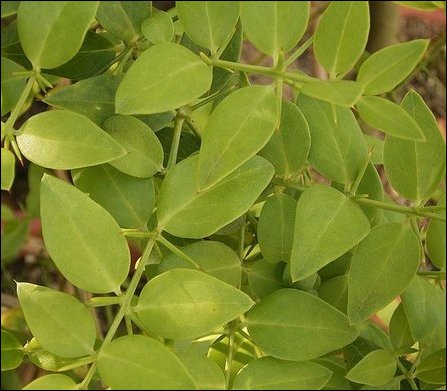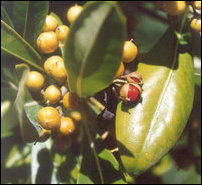Know the Etymology: 264
Place Name of the Day: Wednesday, 12 June 2013
Iyangkan-ve'li, Isankan-ku'lam
இயங்கன் வெளி
இசங்கன் குளம்
Iyaṅkaṉ veḷi
icaṅkaṉ kuḷamIyangkan+ve'li
Isankan+ku'lam
The open land of Mistletoe Berry Thorn
The tank in the locality of Mistletoe Berry Thorn
| Iyangku |
Also Ichangku, Changkagn-chedi, Uvarch-changkam, Mud-Changku: A thorny plant, Mistletoe Berry Thorn, Azima tetracantha, Monetia barlerioides (Tamil, DED 421); Iyangku, I'sangku: The same plant (Malayalam, DED 421); Isagele: The same plant (Kannada, DED 421); Katu-niyada: The same plant (Sinhala)
|
| Ve'li |
(noun) Outside, open space, plain, space, intervening space, gap, room, openness, plainness, publicity, (Tamil, DED 5498); (verb) to be open or public, be vacant, empty (Tamil, DED 5498); Cognates found in Malayalam, Kannada, Telugu, Parji, Gadba, Konda, Kui and Kuwi (DED 5498); Related to Ve'l: White, shining, bright, to dawn; Ve'lichcham: Light (Tamil, DED 5496); and related to Vedi/ Vidi: to dawn; Veddam: Light; Vedda-ve'li: Open plain (Tamil, DED 5475); Veddai, Veddi, Vedduvaan: Open land (Eezham Tamil)
|
| Ku'lam |
Tank, reservoir, lake (Tamil, DED 1828). Cognates found in Malayalam, Kannada, Tulu, Telugu, Gondi and Kui,
|

Iyangku, Isangku, Mistletoe Berry Thorn, Azima tetracantha [image courtesy: Wikipedia]
Iyangku or Isangku is a Tamil/ Malayalam name of a thorny plant that is usually found in arid coastal areas. The name, having a cognate in Kannada too, is taken as belonging to Dravidian etymology (DED 421).
The shrub that grows up to 2 meters in height is also called Iyangka-mu'l or Isangka-mu'l in Eezham Tamil (Mu'l: thorn). Changkagn-chedi, Uvarch-changkam (Uvar: alkaline or saline soil) and Mud-changkam are names of the plant found in medicinal texts.
The plant is called Katu-niyada in Sinhala and the botanical terms are Azima tetracantha and Monetia barlerioides. The common English name is Mistletoe Berry Thorn.
Besides the medicinal use of the shrub, its creeper-like branches with long, four-pronged thorns, resembling barbed wire, are used in hunting bats for meat.
During the fruiting season of trees such as Iluppai (August–September), bats come flying in flocks in the night times to eat the fruits. Lines of Iyangka-mu'l branches tied in a rope across the tree in the flying direction of the bats would trap them.
A recent book written by Mr. P. Kanagasabapathy vividly records the hunting process using Iyangka-mu'l, which he had witnessed in Jaffna in his childhood days (Maram Maanthar Mirukam, 2012, pp 123-126).
* * *The Tamil word Ve'li of Dravidian etymology means an open land or plain.
Ve'l, the root of the word, is related to light and Ve'li meaning an open space is similar to El (light in Dravidian) becoming Eliya (open land) in Sinhala. Another Tamil word, Veddai, meaning an open land, also should be noted here as its root Vedi (meaning dawn) is connected to Ve'li in meaning and in the 'L/ D change.
The etymology of the Tamil/ Dravidian word Ku'lam, meaning a pond, lake or reservoir, is discussed in the earlier columns.
* * *Iyangkan-ve'li is a village in Puthukkudiyiruppu division of Mullaiththeevu district.
Isangkan-ku'lam is a village in Maanthai West division of Mannaar district
* * *Some related place names:Iyangku/ Isangku:Isavup-piddi: The high ground having Isangku shrub; A locality in Thunnaalai in Vadamaraadchi Northeast division of Jaffna district (Balasundaram p.211)
Iyak-kachchi: Probably Iyangku-kachchi: The jungle of Iyangku shrub; Pachchilaippa'l'li division, Ki'linochchi district
Ve'li:Kachchaar-ve'li: The open land of the Kachchaar village; Pachchilaippa'l'li division, Ki'linochchi district. Maasaar and Kachchaar are adjacent villages in Pachchilaippa'l'li
Ve'lik-ka'ndal: The open flood plains; or the open marshland; Ka'ndaava'lai division, Ki'linochchi district
Ponnaa-ve'li: Probably, the open land of Ponnaavirai vegetation; Poonakari division, Ki'linochchi district
Thoadda-ve'li: The open land of the garden; Mannaar Town division, Mannaar district
Aa'lkaaddi-ve'li: The open plain that could show a person in the distance; or the open plain of Aa'lkaaddi birds that alert when they see humans in an expanse; Maanthai West division, Mannaar district
Mu'l'li-ve'li: The open land of of Mu'l'li vegetation; Naanaaddaan division, Mannaar district
Pa'ndaara-ve'li: The open land belonging to State, a royal person or a chieftain; Musali division, Mannaar district
A'ruku-ve'li: The open land of A'ruku grass; Puthukkudiyiruppu division, Mullaiththeevu district
Kusavan-ve'li: The open land of potters (where clay is obtained); Puthukkudiyiruppu division, Mullaiththeevu district
Maruthadi-ve'li: The open land in the locality of a Maruthu tree; Puthukkudiyiruppu division, Mullaiththeevu district
Maavilangkan-ve'li: The open land in the locality of Maavilankai trees; or the open land occasionally found with Maavilankai trees; Puthukkudiyiruppu division, Mullaiththeevu district

Nagnchu'ndaan, Nagnchu'ndai, Pittospermum floribundum [image courtesy: Barbara J. Collins and Lorence G. Collins, callutheran.edu]
The open land of Nagnchu'ndaan trees; Puthukkudiyiruppu division, Mullaiththeevu district. Nagnchu'ndai: Compound corymbed, Yellow-flowered resin seed, Pittospermum floribundum (MTL). The seeds have narcotic content, but are used in native medicine.
Naavaladi-ve'li: The open land in the locality of a Naaval tree; Puthukkudiyiruppu division, Mullaiththeevu diastrict
Paa'ndiyan-ve'li: The open land named after a person of the Paa'ndiyan dynasty; Puthukkudiyiruppu division, Mullaiththeevu district. There are many other place names associated with Paa'ndiyan. The name Veera-Paa'ndiyan is found in two place names, one in Tamil and the other in Sinhala.
Udaiya-ve'li: The open land belonging to a chieftain (Udaiyaar); Puthukkudiyiruppu division, Mullaiththeevu district
Valagnchiyan-ve'li: The open land named after a person of the Veera-valangnchiyar guild; Puthukkudiyiruppu division, Mullaiththeevu district
Ve'li-vayal: The outer paddy field; or the paddy field in the open plain; Puthukkudiyiruppu division, Mullaiththeevu district
Akkarai-ve'li: The open land on the other side of the bank or shore; Karaithu'raippattu division, Mullaiththeevu district
Kariyal-ve'li: The open land of dark soil; or the open land where the vegetation was burnt down; Karaithu'raippattu division, Mullaiththeevu district
Pa'l'la-veli: The open land in the low-lying area; Karaithu'raippattu division, Mullaiththeevu district
Periya-ve'li: The big open land; Karaithu'raippattu division, Mullaiththeevu district: Moothoor division, Trincomalee district
Chaka'laththu-ve'li: The muddy open land; Karaithu'raippattu division, Mullaiththeevu district. Chaka'lai: mud (Tamil)
Ulaththu-ve'li: The open land to dry something; Karaithu'rappattu division, Mullaiththeevu district
Uppu-maa-ve'li: The open land of fine saline soil; or the big open land of saline soil; Karaithu'rappattu division, Mullaiththeevu district
Ve'lik-kudiyiruppu: The settlement in the open land: or the outer settlement; Karaithu'raippattu division, Mullaiththeevu district
Ve'lik-ku'lam: The tank of the open land; Vavuniyaa. Division, Vavuniyaa district
Naavithan-ve'li: The open land of a barber; Naavithanve'li division, Ampaa'rai district
Vellaa-ve'li: The open land with scrub jungle; Vellaave'li division, Batticaloa district
Ammaanthan-ve'li: Probably, the open land of Ammaanthan vegetation; Vaakarai division, Batticaloa district. Ammaanthan could possibly be identified with, Ammaan-pachcharisi (Paalaavip poo'ndu, Euphobia hirta), Amantham (a tree, Kathiraiver Pillai) or Amanthalam (Cheng-kaththari shrub, orbicular leaved caper shrub, MTL).
Kathira-ve'li: The open land of Kathiram (acasia) vegetation; Vaakarai division, Batticaloa district
Koara-ve'li: The open land of Koarai grass; Vaazhaichcheanai division, Batticaloa district
Pearillaa-ve'li: The open land that has no name; Vaazhaichcheanai division, Batticaloa district
Santhi-ve'li: The open land of the junction; Vaazhaichcheanai division, Batticaloa district
Thaa'ndavan-ve'li: The open land named after a person called Thaa'ndavan; Paddippazhai division, Batticaloa district
Pa'ndaariya-ve'li: The open land named after a mendicant; Paddippazhai division, Batticaloa district
Aanai-kaddiya-ve'li: The open land where elephants were chained: Vellaave'li division, Batticaloa district
Ka'lumunthan-ve'li: The open land of Ka'lu-munthan; Vellaave'li division, Batticaloa district. Ka'lu-munthan is likely to be a spirit of dark appearance in folk belief.
Kuchcha-ve'li: The open land of reeds; Kuchchaveli division, Trincomalee district
Nilaa-ve'li: Probably, the open land of Nilaavirai (cassia) vegetation; Kuchchave'li division, Trincomalee district
Peru-ve'li: The big open land; Moothoor division, Trincomalee district
Maanaya-ve'li: The open land, which is an endowment; Trincomalee Town and Gravets division, Trincomalee district
Uppu-ve'li: The open land of saline soil; Trincomalee Town and Gravets division, Trincomalee district
Pa'ravai-ve'li: The open land of birds; Musali division, Mannaar district
First published: Wednesday, 12 June 2013, 06:48
Previous columns:








